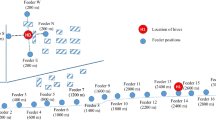Abstract
In the vicinity of a dancer, a honeybee can become a dance follower after touching the dancer or a dance follower with an antenna. If the attraction occurs without such antennal contact, the strength of the attraction over distance depends on several factors: the kind of dance floor (empty open cells versus capped brood cells); whether dancers and dance followers stand on the same substratum or on separate substrata; the position and direction of the attracted bee relative to the dancer bee; the size of the dance group (the dancer plus follower bees); and the light conditions under which the dance takes place. Dances on open cells are significantly more attractive than dances on sealed cells. Dancers on open cells attracted 90% of all followers from within 27 mm (about five to six cell diameters). Dancers on sealed cells attracted 90% of all followers within 18 mm (about three cell diameters). The majority of bees that were attracted by the dancer were standing laterally to the dancer. Dances illuminated by artificial visible light are significantly more attractive than dances illuminated by infrared light. As a group, “glassplate bees” (bees standing mechanically isolated from the dancer bee) were least attracted.
Similar content being viewed by others
Author information
Authors and Affiliations
Additional information
Accepted: 11 August 1998
Rights and permissions
About this article
Cite this article
Tautz, J., Rohrseitz, K. What attracts honeybees to a waggle dancer?. J Comp Physiol A 183, 661–667 (1998). https://doi.org/10.1007/s003590050289
Issue Date:
DOI: https://doi.org/10.1007/s003590050289




